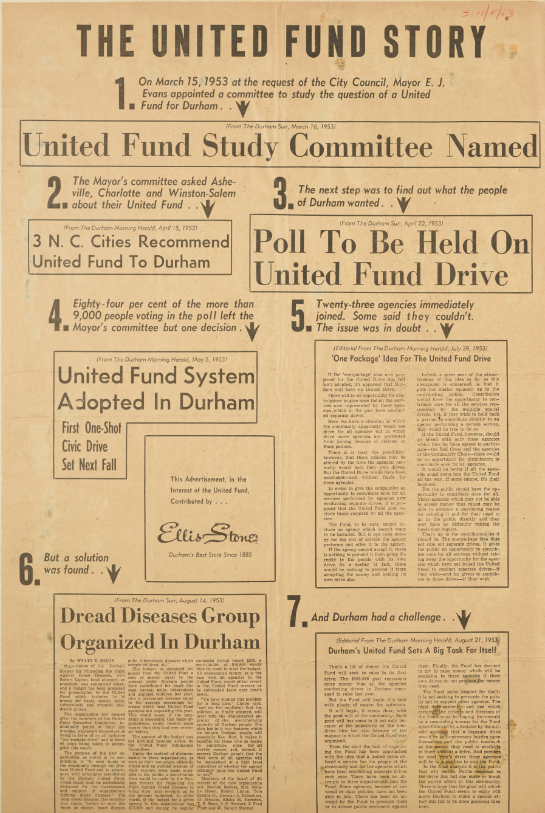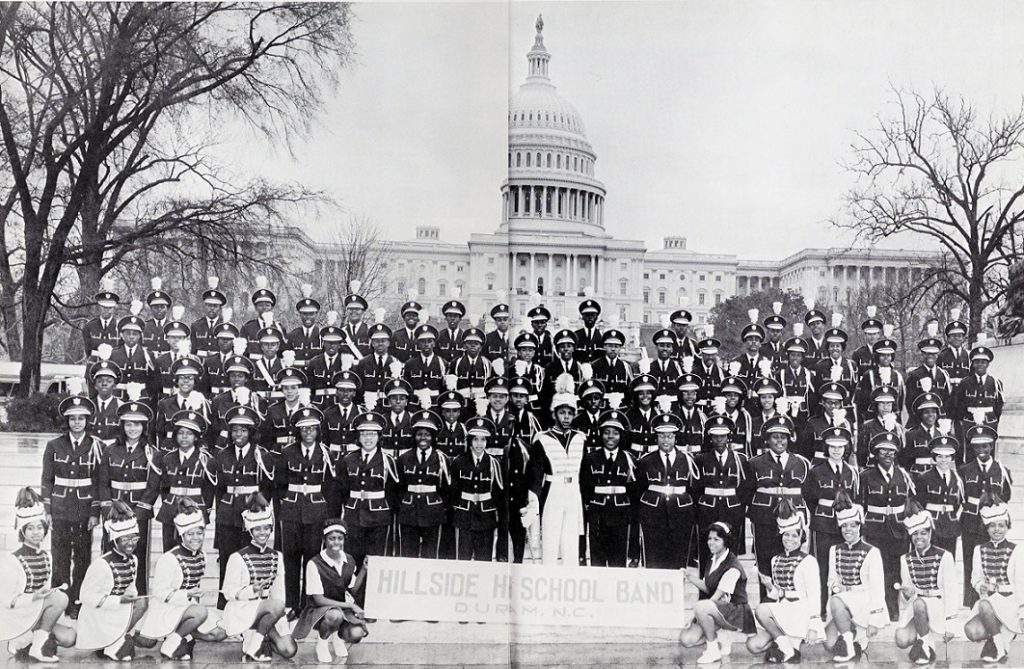
The 1963 Hillside High School Marching Band on a trip to Washington, D.C.
A new batch of yearbooks from Durham County are now available on DigitalNC, courtesy of a new partner, the Museum of Durham History. Included in this collection are two yearbooks from Hillside High School in Durham, the 1960 and 1963 editions of The Hornet. Hillside High School was the Black high school in Durham before integration and it remained a high school following integration, which was rare in North Carolina. The school today has a long, proud history.
These yearbooks contain individual student portraits, as well as class portraits and photographs of school faculty. The yearbooks also highlight aspects of the student life and student experience, including senior superlatives and class reminiscences. They also contain photographs and group portraits of student councils, clubs and activities like marching band and the school orchestra, the 1963 homecoming and a variety of sports teams. Finally, there is also a memorial in dedication to a student who passed away during the 1960 school year.
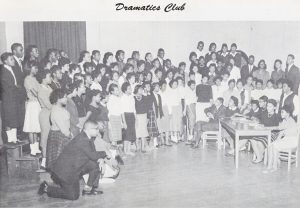
The 1960 Dramatics Club at Hillside High School
Follow the links below to browse the yearbooks included in this batch:
This new batch of yearbooks, the first of their kind from Hillside High School, is a valuable addition to DigitalNC. To see more from the Museum of Durham History, please check out their partner page or visit their website.
In the early days of the North Carolina Digital Heritage Center, we digitized thousands of records created during the Durham Urban Renewal Project. Recently, we revisited these records with the intention of making them more accessible and useful to our partners and the public.
The Durham Redevelopment Commission was established in 1958 with the intention eliminating “urban blight” and improving the city’s infrastructure as more and more personal vehicles filled the city’s streets. Durham Urban Renewal targeted seven areas — one in Durham’s downtown district and six in historically Black neighborhoods including Hayti and Cleveland-Holloway. The projects in these six neighborhoods impacted approximately 9,100, or 11.7%, of Durham citizens at the beginning of the project in 1961. Although the initial timetable for the project was ten years, the project efforts went on for nearly 15 years and was ultimately never completed. By the end of the urban renewal efforts, more than 4,000 households and 500 businesses were razed and a new highway — NC 147 — stretched through the heart of Durham.
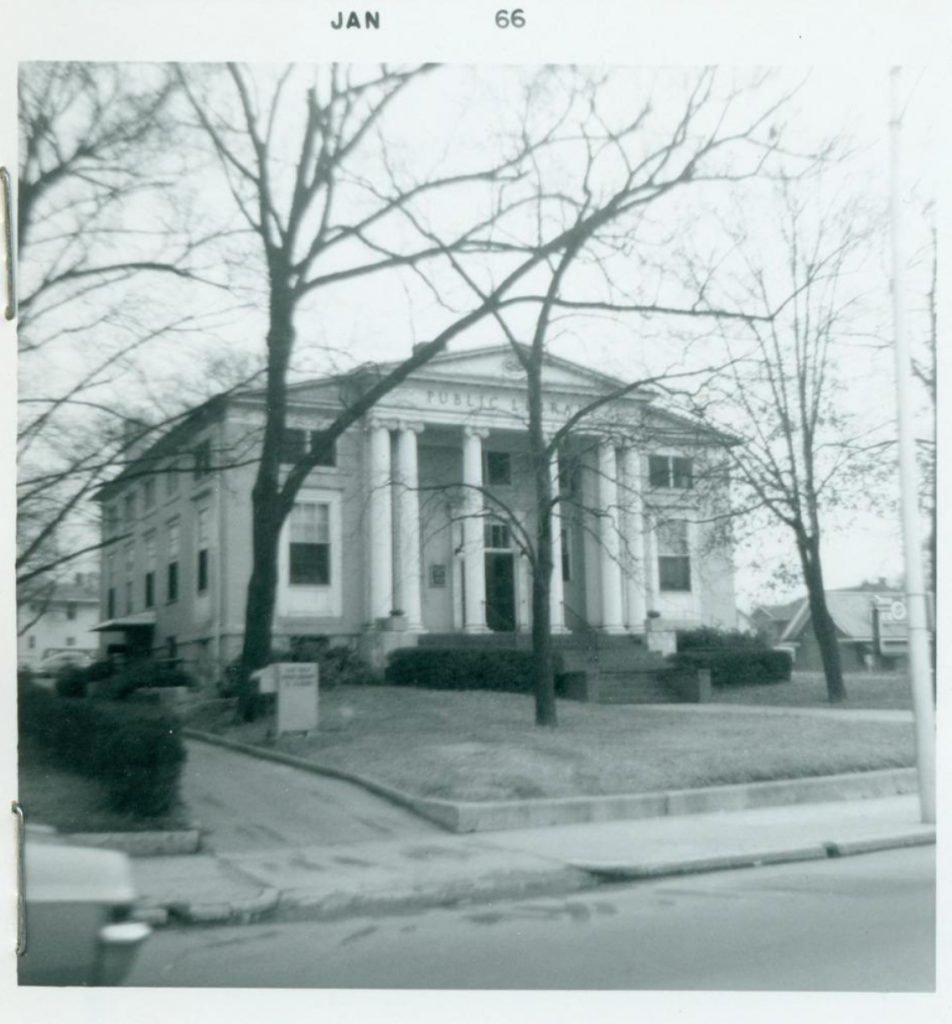
Some structures included in the collection, such as the second home for the main branch of the Durham Public Library, outlived the urban renewal project and still stand today. This building is located at 311 East Main Street.
The Durham Urban Renewal Collection contains studies, reports, appraisals, property records, photographs, brochures, and clippings that span the nearly 20 years of urban renewal projects. These materials are artifacts of Durham before, during, and after urban renewal dramatically altered the city.
In an effort to make these materials as accessible and accurate as possible, we recently completed a major cleanup of the collection. Properties are now listed by complete street address. Many of the residential properties — and some commercial properties — were appraised more than once during the urban renewal process. We have consolidated all appraisals, photographs, and other records for individual properties into single listings, and text in these records are full-text searchable. We also used historical maps of the city from the years of urban renewal to provide additional information for unaddressed or mislabeled appraisals and records. In addition to the changes made to improve accessibility by address, we made efforts to ensure that the names of property owners are complete, accurate, and consistent across the collection, so that records may be located more easily in searching by the owners’ names.
The materials in the Durham Urban Renewal Collection came from Durham County Library’s North Carolina Collection and are only a portion of the materials contributed by the library to date. To learn more about the Durham County Library, visit their website or partner page.
A batch of scrapbooks documenting Durham’s United Fund Campaign are now online at DigitalNC courtesy of our partner Durham County Library. These scrapbooks hold newspaper clippings and advertisements for the United Fund for the years 1953 and 1955 to 1960. Efforts to develop a United Fund for Durham officially began in 1953, so these scrapbooks document the early days of the fund and its subsequent growth.
The United Fund joined the campaigning efforts of more than 30 Durham community organizations in an effort to lessen the fundraising burden of each and increase the funds raised for all. The scrapbooks detail the ways in which many local businesses and citizens donated to the United Fund. Monies collected went to support organizations like the Girl Scouts, the Red Cross, and to fight diseases such as polio, cancer, tuberculosis, and heart disease.
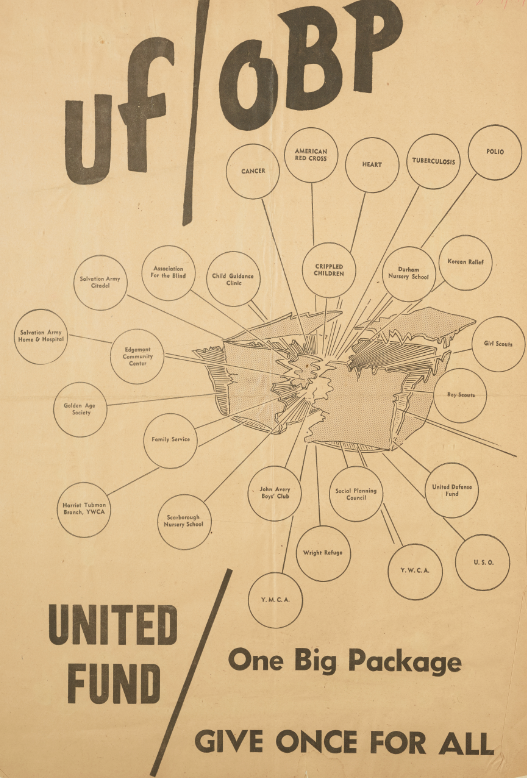
An advertisement from a local newspaper encouraged citizens to “Give Once For All” for Durham’s United Fund and detailed many of the organizations included.
Some of the clippings promise that displaying evidence of earlier contribution “provides the basis for immunity from further solicitation” by any of the organizations included in the United Fund.

This clipping promises “immunity from further solicitation” once donations were made to The United Fund.
Others communicate the fund’s urgency in some interesting ways … like by asking if participants will need “victory whistles or crying towels” at the next meeting.
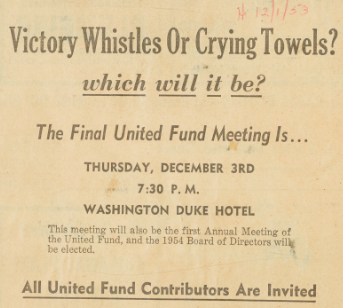
United Fund contributors were invited to the first annual meeting.
These scrapbooks detail times of considerable change in Durham, and join an already substantial collection from Durham County Library. To access more from Durham County Library, visit their partner page or their website.
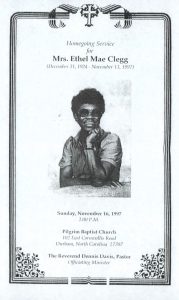
The first page of the funeral program for Mrs. Ethel Mae Clegg
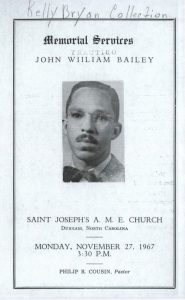
The first page of the funeral program for John William Bailey
Hundreds of funeral programs and obituaries from the R. Kelly Bryant Obituary Collection, physically housed at the Durham County Library North Carolina Collection, are now up on DigitalNC. R. Kelly Bryant (1917-2015) was a historian with an extensive knowledge of Durham, North Carolina. In addition to being an active community leader with involvement in many organizations, he also collected the stories of thousands of African American residents told through funeral programs and obituaries.
This collection consists of digitized photocopies of the obituaries and funeral service programs that R. Kelly Bryant assembled over the course of his 70-odd years as a Durham resident. They are grouped together alphabetically according to surname of the deceased. The surnames “Adams,” through “Coachman” are now available, but we will continue to add more names to the digitized collection.
These materials are text searchable, and often contain genealogical information on their subjects including birth and death dates, maiden names, names of relatives, past residences, and places of burial. They cover funerals held from 1934-2013, and provide rich documentation of the African American community in Durham during this time. To learn more about Mr. Bryant and view his archival collection at Durham County Library, visit the finding aid. To see all of the digitally available programs, visit the R. Kelly Bryant Obituary Collection exhibit page.
Also please take a look at other materials from the Durham County Library that are up on DigitalNC by visiting their partner page.
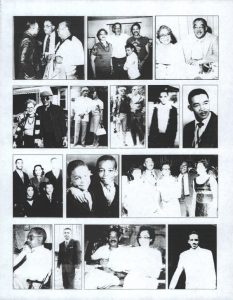
A page of photographs from the funeral program of Edward Beckford “Pe Wee” Boyd
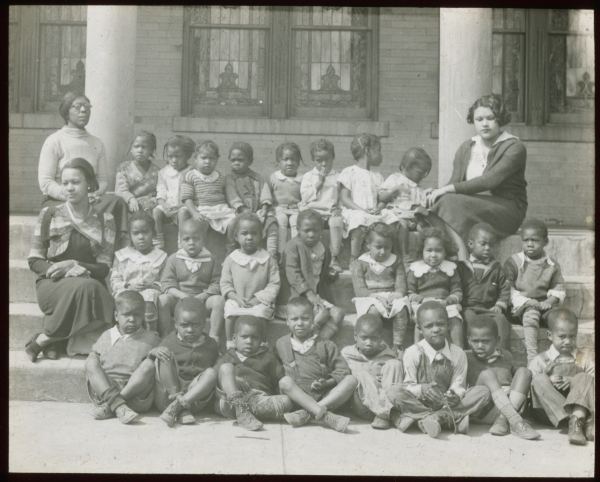
Elementary school class portrait on steps of an unidentified building
The William Franklin Warren Durham City School Slide Collection, featuring almost 600 lantern and Kodachrome slides, is now available on DigitalNC. This collection is from Durham County Library, and show images of Durham city schools, both White and African-American, from the 1930s and 1940s. The slides include images of classroom scenes, school celebrations, exterior shots of school buildings, a high school class trip to Williamsburg and Richmond, VA, group portraits of sports teams, portraits of teachers and school administrators, and more. Schools highlighted include Hillside High School and Durham High School, as well as many elementary and junior high schools that no longer exist. Rosenwald schools are also featured in the images. In addition there are slides from various school presentations that report district valuations and statistics, and images of other locations in Durham such Duke University, downtown Durham, mills and factories, the Durham Athletic Park, and residential neighborhoods, including Hope Valley. These slides provide rich documentation of segregated Durham school life through the Great Depression and World War II.
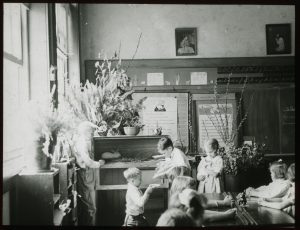
Elementary school students taking care of class rabbits
The slides were most likely taken by William Franklin “Frank” Warren (1887-1979), the superintendent of Durham city schools from 1933-1947. In the early twentieth century, Durham’s schools were organized in two separate systems, the county schools and the city schools. Durham city schools originated with the establishment of a graded school system in 1882, with the first white graded school opening in 1882 followed by the first Black graded school in 1885. As elsewhere in the South, the schools at this time were segregated.
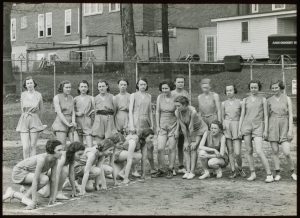
Durham High School girls’ gym class
Click here to browse all of the slides in this collection, and here to take a look at Durham County Library’s finding aid. Learn more about Durham County Library by visiting their partner page or website.
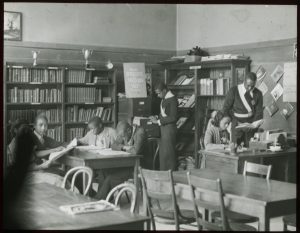
Students studying at the library
Durham has long been a center of the arts in the Triangle, with dance being no exception. The American Dance Festival (ADF) has been a part of the Durham community since 1978. The ADF began in 1934 at Bennington College in Vermont and moved to several other New England campuses, until it finally settled at Duke University, where it has remained for almost forty years. This event helped to foster the many dance and performance organizations in the area and increase the popularity of dance in the local Durham community, as well as around the Triangle.
The “Arts in Durham” television broadcast documented several studios and clubs that stemmed from this popularity during the late 1970’s. Although the ADF focused primarily on modern dance, many different genres were represented in these broadcasts, including disco, ballet, jazz, and clogging. Below are three “Arts in Durham” broadcasts from DigitalNC’s North Carolina Sights & Sounds Collection, highlighting the wonderful and weird dance styles from the Durham community.
Arts in Durham: Arthur Hall Dance Company
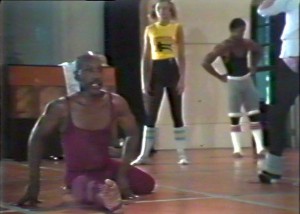
Arthur Hall teaching technique at the American Dance Festival.
Arthur Hall, founder of the Dance Company with his name sake, came to the ADF from Philadelphia to teach techniques based in traditional African movements. Trained under a Ghanaian instructor, Hall dedicated his life to creating a space for Black dancers to practice and perform traditional and original choreography. Outside of dance, Hall created a museum, cultural center and archive in Germantown. He has been called the “father of the Black arts movement in Philadelphia,” and his techniques inspired the Durham Arts community during his time with ADF.
Arts in Durham: C’est La Vie Disco
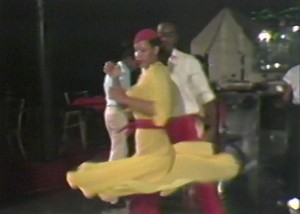
C’est La Vie Disco
Although ADF showcased professional dancers and choreographers, professional dance was not all that existed during this period in Durham. C’est La Vie Disco embraced the disco craze of the seventies in a way that amateurs and professionals alike could enjoy. Located in Durham’s old Five Point Neighborhood, C’est La Vie Disco was housed in a restaurant that made room for DJs and dancers in the evenings. The broadcast features several professional teachers, demonstrating disco techniques, but the true highlights are the intro and concluding pieces that showcase community members busting some moves.
Art in Durham: New Performance Dance Company, April 1979
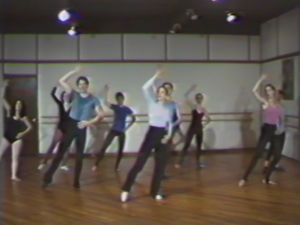
Probably the most entertaining of all of the dance-related audiovisual material on DigitalNC, this broadcast features the New Performance Dance Company, once located on Chapel Hill Street in Durham. The company choreographed and performed in the area and taught classes of various styles. The broadcast features several modern performances, disco choreography, and children’s classes. Many of these dance styles are quite unique and definitely worth watching!
You can see all of the dance-related moving images at the links below or continue exploring the Arts in Durham . Many thanks to the Durham County Library for contributing these pieces of history from the Triangle.
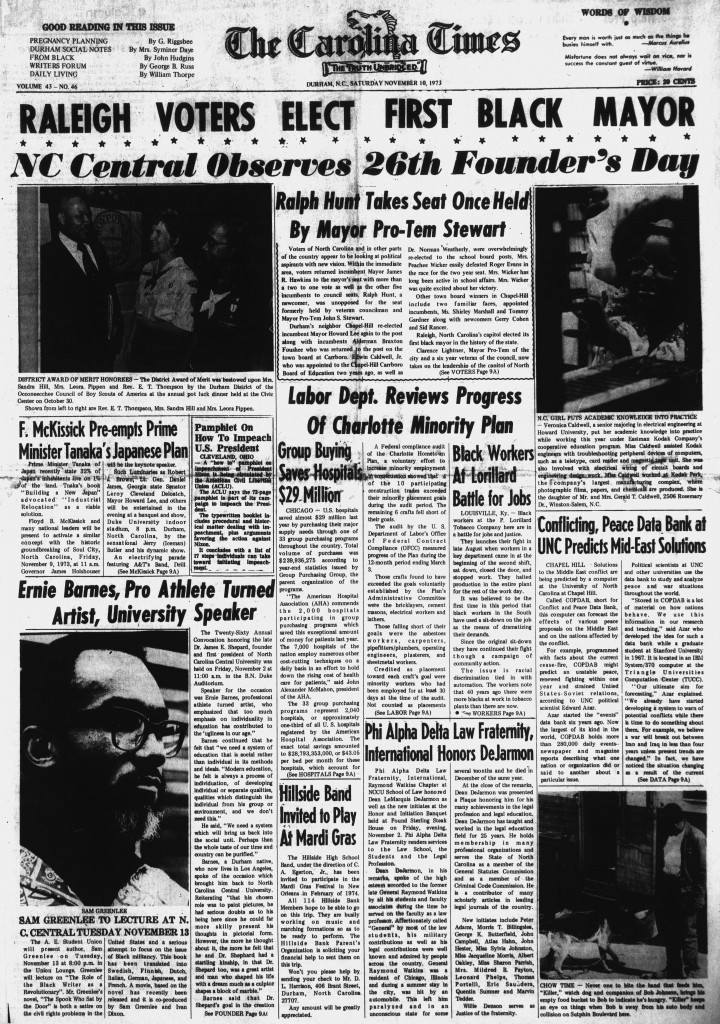
November 10, 1973 issue of The Carolina Times
One of the more frequently used newspapers on our site is The Carolina Times, a weekly newspaper from Durham. We recently added more issues, covering the years 1973-1982.
As mentioned in earlier posts, The Carolina Times was edited and published by Louis Austin. The paper covered and addressed issues most pressing to the African American community in Durham, with local news as well as national coverage.
This title was suggested for digitization by the Durham County Library. You can view other items digitized for the Library on DigitalNC, and also check out their own rich online collections.
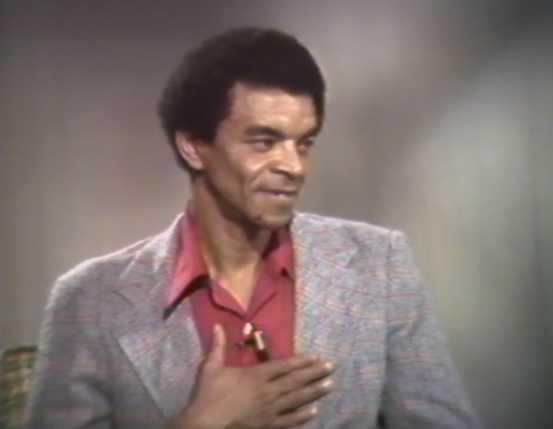
Yusuf Salim interviewed for Durham Technical Institute and Arts in Durham.
From Durham Technical Institute’s Community Video Services and the Durham Arts Council, Cynthia Watts interviews Yusuf Salim in Arts in Durham, Brother Yusuf, 1979. This moving image can be found in DigitalNC’s new North Carolina Sites and Sounds Collection. It was contributed by the Durham Public Library.
Born Joseph Blair in Baltimore in 1929, Yusuf Salim was a lifelong Jazz pianist and composer, performing in several bands in Baltimore, New York City, and Durham. Salim was a well-known figure in Durham, but apart from his small collection of archival material, his memory now resides mainly in the hearts of Durhamites who knew him. He served as a resource for the growing jazz community and often helped and hosted musicians who were settling in or passing through the Triangle. He was also known as a humanitarian and community activist, promoting peace among the rapidly diversifying population in the Triangle.
In the film, Watts askes Salim “Why did you choose Durham?” (3:14)
“Durham chose me.” Salim continued to describe his love of the Triangle area. He discussed the many “points of reference” by which he compared his experience. One such moment was his time as a Marine in Eastern North Carolina. Even in his full Marine uniform he was forced to walk in the dirt to let white people pass. But times had changed in the Triangle and Salim’s attitude and outlook were positive, which he credits to his Islamic faith. Salim also spoke openly about his struggle with heroin and how his faith freed him from his addiction. He went cold-turkey upon his move to Durham in 1974 and was clean from then on.
More than half of the moving image is dedicated to what Salim did best– jazz performance. The film documents 15 minutes of Salim’s skill on the jazz piano.
Two other moving image items from the the Durham Public Library that also feature Salim are available on DigitalNC:
Salim died in 2008 after a battle with prostate cancer. His memorial was held at the Hayti Heritage Center in Durham. This moving image offers a warm memory of a beloved Durham jazz icon and captures a moment of the art scene in the Triangle during the 1970’s. For more information and research about Yusuf Salim and his life in Durham, please visit Duke University’s Rubenstein Library where his collection is housed. It holds many of the original scores that he composed. Related material about Jazz in Durham can be found at the Durham Main Library in the Bus Brown Collection. You can also view many other materials shared by Durham County Library on DigitalNC or in their own digital collections.
A large collection of property appraisals and photographs from the Durham Urban Renewal Records in the Durham County Library is now available on DigitalNC. The online collection contains nearly 1,500 items, most of which are photographs and appraisals for properties slated for demolition during renewal projects in the 1960s and 1970s. These records provide a fascinating look at the history of Durham, enabling users to view and study houses and even whole neighborhoods that no longer exist.
Learn more about the collection — and Durham history in general — at the North Carolina Collection in the Durham County Library.
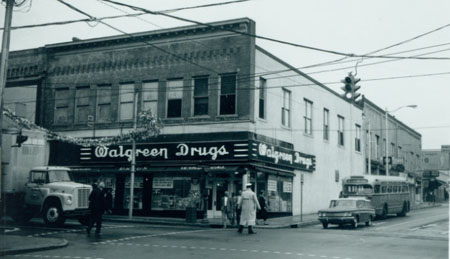
Walgreen Drugs at 102-104 W Main Street, 107 N Mangum Street
A large collection of urban renewal records from Durham County Library’s North Carolina Collection will be digitized by the North Carolina Digital Heritage Center and published on DigitalNC.org. These records include property appraisals and photographs taken in the 1960s and 1970s, and include a significant amount of information about Durham’s historically Black neighborhoods, including Hayti.



